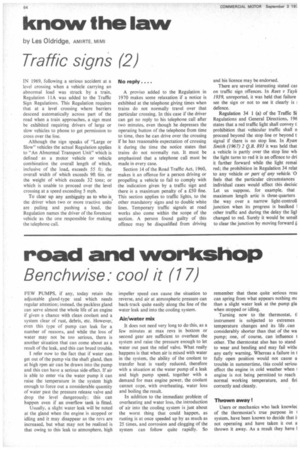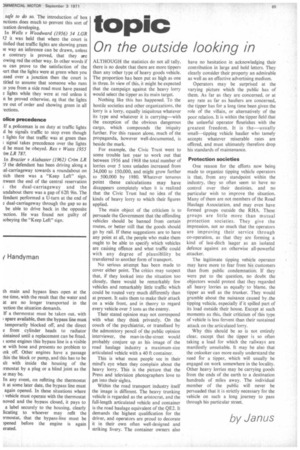road and workshop
Page 66

Page 67

If you've noticed an error in this article please click here to report it so we can fix it.
Benchwise: coo/it (17)
Handyman
FEW PUMPS, if any, today retain the adjustable gland-type seal which needs regular attention; instead, the packless gland can serve almost the whole life of an engine if given a chance with clean coolant and a system clear of rust, debris, etc. However, even this type of pump can leak For a number of reasons, and while the loss of water may not be too serious, there is another situation that can come about as a result of the leak, and this can breed trouble.
I refer now to the fact that if water can. get out of the pump via the shaft gland, then at high rpm air can be drawn into the pump and this can have a serious side-effect. If air is able to enter via the water pump it can raise the temperature in the system high enough to force out a considerable quantity of water past the pressure release valve and drop the level dangerously; this can happen even if an overflow tank is fitted.
Usually, a slight water leak will be noted at the gland when the engine is stopped or idling and it may disappear as the revs are increased, but what may not be realized is that owing to this leak to atmosphere, high impeller speed can cause the situation to reverse, and air at atmospheric pressure can back-track quite easily along the line of the water leak and into the cooling system.
Air/water mix
It does not need very long to do this, as a few minutes at max revs in bottom or second gear are sufficient to overheat the system and raise the pressure enough to let water out past the relief valve. What really happens is that when air is mixed with water in the system, the ability of the coolant to transfer heat is vastly reduced, therefore with a situation at the water pump of a leak and high pump speed, together with a demand for max engine power, the coolant cannot cope, with overheating, water loss and boiling the result.
In addition to the immediate problem of overheating and water loss, the introduction of air into the cooling system is just about the worst thing that could happen, as rusting is at once speeded up by as much as 25 times, and corrosion and clogging of the system can follow quite rapidly. So remember that these quite serious resu can spring from what appears nothing mc than a slight water leak at the pump gla when stopped or idling.
Turning now to the thermostat, tl instrument is subjected to extremes temperature changes and its life , can considerably shorter than that of the wa pump; one, of course, can influence I other. The thermostat also has to stand to wear and bending and may fail with( any early warning. Whereas a failure in I fully open position would not cause a trouble in summertime, this could seriou: effect the engine in cold weather when 1 engine is not being permitted to reach normal working temperature, and firi correctly and cleanly.
Thrown away !
Users or mechanics who lack knowlec of the thermostat's true purpose in I system, have been known to decide that ii not operating and have taken it out a thrown it away. As a result they have I safe to do so. The introduction of box nctions does much to prevent this sort of tuation developing.
In Wells v Woodward (1956) 54 LGR t2 it was held that where the court is tisfied that traffic lights are showing green te way an inference can be drawn, unless
e contrary is proved, that they are owing red the other way. In other words if m can prove to the satisfaction of the iurt that the lights were at green when you issed over a junction then the court is titled to assume that someone who runs to you from a side road must have passed
e lights while they were at red unless it in be proved otherwise, eg that the lights ;re out of order and showing green in all -ections,
olice precedence If a policeman is on duty at traffic lights d he signals traffic to stop even though lights for that traffic was at green then ; signal takes precedence over the lights
d he must be obeyed. Rex v Watts 1955 LR 787.
In Brazier v Alabaster (1962) Crim LR '3 the defendant has been driving along a al-carriageway towards a roundabout on iich there was a "Keep Left" sign. :tween the end of the central reservation
the dual-carriageway and the undabout there was a gap of 62ft 9in. The fendant performed a U-turn at the end of e dual-carriageway through the gap so as be able to drive back in the opposite -ection. He was found not guilty of 3obeying the "Keep Left" sign.
th main and bypass lines open at the me time, with the result that the water and at are no longer transported in the -ection the situation demands.
If a thermostat must be taken out. with spare available, then the bypass line must temporarily blocked off, and the direct e from cylinder heads to radiator tintained until a replacement can be fitted. some engines this bypass line is a visible x with hose and presents no problem to ink off. Other engines have a passage thin the block or pump, and this has to be alt with inside the housing of the xmostat by a plug or a blind joint as the se may be.
In any event, on refitting the thermostat it at some later date, the bypass line must again opened. In these situations where : vehicle must operate with the thermostat noved and the bypass closed, it pays to a label securely to the housing, clearly Heating to whoever may refit the !..rmostat, that the bypass-line must be vened before the engine is again crated.










































































































































